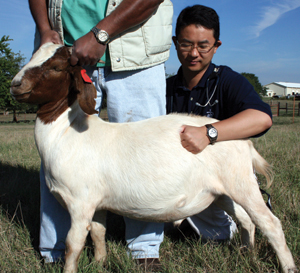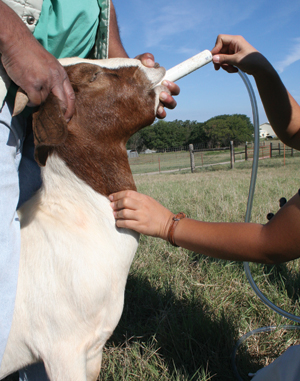Physical Evaluation
Listed below are brief explanations to guide a producer in evaluating a healthy animal. Any question about the condition or health status of an animal should be referred to a veterinarian; if in doubt, consult a veterinarian.
Rectal Temperature
The first step in evaluating whether an animal is healthy is to take its temperature; in goats, this is done rectally. A digital thermometer works well; a plastic digital thermometer is very safe and will not break like a glass thermometer. A small amount of lubricant, such as petroleum jelly, can be put on the thermometer. Insert the thermometer with a twisting motion. A goat’s normal temperature should be 103° to 104°F (39° to 40°C).
Pulse or Heart Rate
The pulse or heartbeat can be felt and measured on several places on a goat. Heartbeat can be felt by placing one’s fingertips between the ribs behind the elbow. The pulse can be measured using the femoral artery on the inside of the goat’s rear leg roughly one-third of the way down the thigh. Pulse may also be detected by placing the index and middle fingers on the artery located below and slightly inside the jaw roughly two-thirds to the rear of the muzzle. A normal range is 70 to 90 beats per minute.
Respiration
Respiration is detected by watching the movement of the flank or chest. A normal range is 12 to 20 breaths per minute.
Checking Mucous Membranes
Paleness of the mucous membranes in the mouth (gums), vagina, and prepuce can be an indicator that the animal is in hypovolemic shock, meaning that there is a decrease in the blood volume circulating in the animal. The color of the conjunctiva around the eyes can be an indicator of anemia that could be caused by a heavy internal parasite burden.
Roll down the lower eyelid to look at the color. A pale, whitish color indicates anemia. This color can be scored using the FAMACHA system http://www.acsrpc.org/, which is described in the section on “Parasites of Goats.” Remember that irritation of any type causes membranes to turn red. This means that an anemic goat with pinkeye may still have red membranes.
Rumen Movements
Normal rumen function is essential for the goats health. One sign of normal function is regular contractions that mix the rumen contents in the digestion process. Normal movements can be detected by placing the hand on the left flank of the animal. If the rumen feels soft and water-filled this should be noted and reported to your veterinarian. Rumen contractions occur 1 to 2 times per minute.
Tubing an animal
Sometimes it is necessary to pass a tube down the mouth directly into the stomach in order to administer a large volume of liquid. This can also be done in the treatment of bloat. The size of the tube passed should be appropriate for the animal’s size. Generally a 1/2 to 3/4 inch (1 to 2 cm) diameter tube should be used for adult goats. A short metal or PVC pipe, function as a speculum, is larger in diameter than the tube to be inserted is placed in the mouth to prevent the goat from biting or chewing the plastic tube. The tube should be measured and marked at the length from the mouth to the 13th rib, as the end of the tube. This will prevent passing the tube too far. Fluids should be administered carefully and slowly. Caution should be taken to avoid inserting the tube into the trachea, therefore have a veterinarian or person trained in this technique instruct you before attempting it the first time.
Bolus Administration – Balling
A balling gun is used to administer tablets or boluses to an animal. A balling gun has a holder for the tablet in the end and a plunger to expel the tablet into the throat. Large boluses sould be lubricated with vegetable or mineral oil for easier swallowing. Pass the balling gun over the hump of the tongue and press the plunger while holding and tilting the goats head upwards. Ensure the tablet is swallowed by holding the mouth shut. Stroking the throat can also elicit a swallowing reflex. Be gentle while placing the balling gun into the mouth and expelling the pill. This delicate tissues of the throat are easily injured by the balling gun and pills sharp edges. This can leave the goat with a seriously injured or with a sore throat and will not eat.
Reference
Meat Goat Production Handbook, Langston University






